| Augustus Leopold EggRA | |
|---|---|
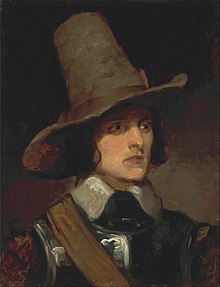 Augustus Egg by Richard Dadd (between 1838 and 1840) Augustus Egg by Richard Dadd (between 1838 and 1840) | |
| Born | 2 May 1816 |
| Died | 26 March 1863 (aged 46) |
| Nationality | British |
| Movement | The Clique |
| Elected | Royal Academy of Arts |
Augustus Leopold Egg RA (2 May 1816 – 26 March 1863) was a British Victorian artist, and member of The Clique best known for his modern triptych Past and Present (1858), which depicts the breakup of a middle-class Victorian family.
Biography
Egg was born in London to Joseph and Ann Egg, and baptised in St James's Church, Piccadilly, on 30 May 1816. He had an elder brother, George Hine Egg.
His father Joseph Egg was a wealthy gunsmith from the distinguished gun making family, who immigrated to London from Huningue, Alsace. Egg was educated in the schools of the Royal Academy, beginning in 1836. Egg was a member of The Clique, a group of artists founded by Richard Dadd and others in the late 1830s (c. 1837). Egg sought to combine popularity with moral and social activism, in line with the literary work of his friend Charles Dickens. With Dickens he set up the "Guild of Literature and Art", a philanthropic organisation intended to provide welfare payments to struggling artists and writers. He acted the lead role in "Not So Bad As We Seem," a play written by Edward Bulwer-Lytton to raise funds for the organisation. His self-portrait in the role is in Hospitalfield House in Arbroath.
Egg's early paintings were generally illustrations of literary subjects. Like other members of The Clique, he saw himself as a follower of Hogarth. His interest in Hogarthian moral themes is evidenced in his paired paintings The Life and Death of Buckingham, depicting the dissolute life and sordid death of the Restoration rake George Villiers, 2nd Duke of Buckingham. Yet his paintings often took a humorous look at their subjects, as in his Queen Elizabeth Discovers she is no longer Young (1848).
Style
Unlike most other members of The Clique, Egg also admired the Pre-Raphaelites; he bought work from the young William Holman Hunt and shared ideas on colour theory with him. His own triptych, known as Past and Present, was influenced by Hunt's work. The triptych depicted three separate scenes, one portraying a prosperous middle-class family and the other two depicting poor and isolated figures – two young girls in a bedsit and a homeless woman with a baby. The viewer was expected to read a series of visual clues that linked together these three scenes, to reveal that the prosperous family in the central scene is in the process of disintegrating because of the mother's adultery. The two outer scenes depict the separated mother and children a few years later, now living in poverty. The painting's use of flashback – the central scene is occurring in the past – has been seen as a precursor of cinema.

Egg was also an active organiser of exhibitions, being admired by fellow-artists for his dedication and fair mindedness. He was one of the organisers of the Manchester Art Treasures Exhibition in 1857. He was elected to the Royal Academy in 1860.
Always in poor health, Egg spent his later years in the warmer climate of continental Europe, where he painted Travelling Companions, an ambiguous image of two near-identical young women that has sometimes been interpreted as an attempt to represent two sides of the same person. A member of the circle of friends that included Dickens and Wilkie Collins, Egg features in their surviving correspondence. He participated, as actor and costume designer, in their amateur theatricals, which were often conducted for charitable purposes as noted above. In January 1857 he took a part in Collins's play The Frozen Deep, which starred Dickens and was performed at his home, Tavistock House (Egg played John Want, the ship's cook.) The production was also acted before Queen Victoria and then performed for charity. Dickens described Egg as a "dear gentle little fellow", "always sweet-tempered, humorous, conscientious, thoroughly good, and thoroughly beloved."
Egg died in Algiers on 26 March 1863.
In a 1953 radio interview, novelist Evelyn Waugh was asked "What painters do you admire most?" He answered "Augustus Egg I’d put among the highest."
Gallery
Past and Present – 1858 triptych
Select paintings
-
 Queen Elizabeth discovers she is no longer young, 1848
Queen Elizabeth discovers she is no longer young, 1848
-
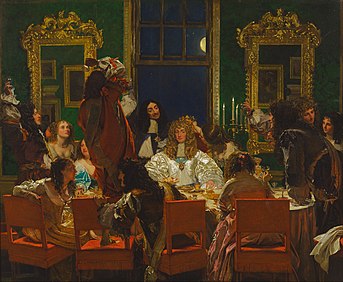 The Life and Death of Buckingham: The Life of Buckingham, c. 1855
The Life and Death of Buckingham: The Life of Buckingham, c. 1855
-
 The Life and Death of Buckingham: The Death of Buckingham, c. 1855
The Life and Death of Buckingham: The Death of Buckingham, c. 1855
-
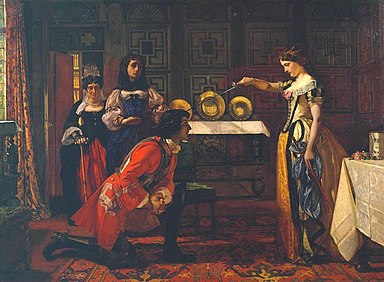 Beatrix Knighting Esmond, 1857
Beatrix Knighting Esmond, 1857
-
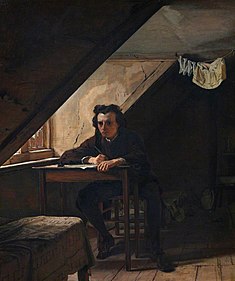 Self Portrait as a Distressed Poet, 1858
Self Portrait as a Distressed Poet, 1858
-
 Taming of the Shrew, 1860
Taming of the Shrew, 1860
-
 Unknown woman, formerly known as Florence Nightingale
Unknown woman, formerly known as Florence Nightingale
-
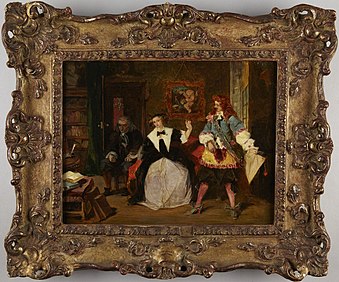 Madame de Maintenon and Scarron
Madame de Maintenon and Scarron
-
 The Love Letter, by 1863
The Love Letter, by 1863
Notes
- "Augustus Egg – British painter".
- Hilarie Faberman, 'Egg, Augustus Leopold (1816–1863)’, Oxford Dictionary of National Biography, Oxford University Press, Sept 2004
- "Augustus Egg". All things Victorian. Archived from the original on 27 January 2017. Retrieved 28 September 2021.
- Chisholm, Hugh, ed. (1911). "Egg, Augustus Leopold" . Encyclopædia Britannica. Vol. 09 (11th ed.). Cambridge University Press. p. 13; second para.
Among his principal pictures may be named:....1848, "Queen Elizabeth discovers she is no longer young"...
- Ley, p. 283.
- Excerpts from the text of the broadcast, on 16 November 1953, are given in the 1998 Penguin Books edition of The Ordeal of Gilbert Pinfold, pp. 135–43.
References
- Collins, Wilkie. Letters of Wilkie Collins. Edited by William Baker and William Malpas Clarke; London: Palgrave Macmillan, 1999.
- Cowling, Mary. Victorian Figurative Painting. London, Andreas Papadakis Publisher, 2001.
- Ley, J. W. T. The Dickens Circle: A Narrative of the Novelist's Friendships. New York: E. P. Dutton, 1919.
- Valentine, Helen, ed. Art in the Age of Queen Victoria: Treasures from the Royal Academy of Arts Permanent Collection. New Haven and London: Yale University Press / Royal Academy of Arts, London, 1999.
External links
- 30 artworks by or after Augustus Leopold Egg at the Art UK site
- Phryne's list of pictures in accessible collections in the UK


